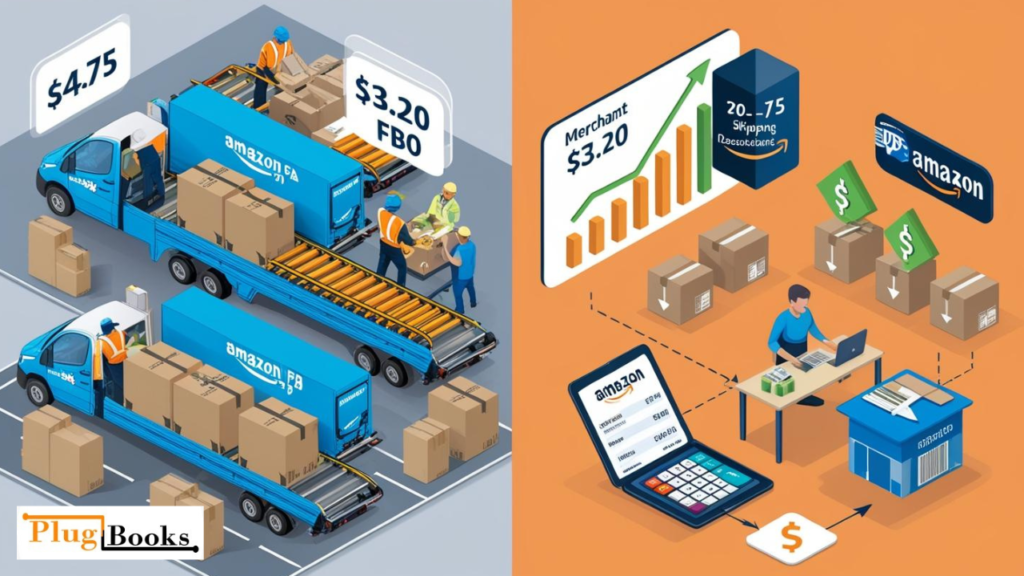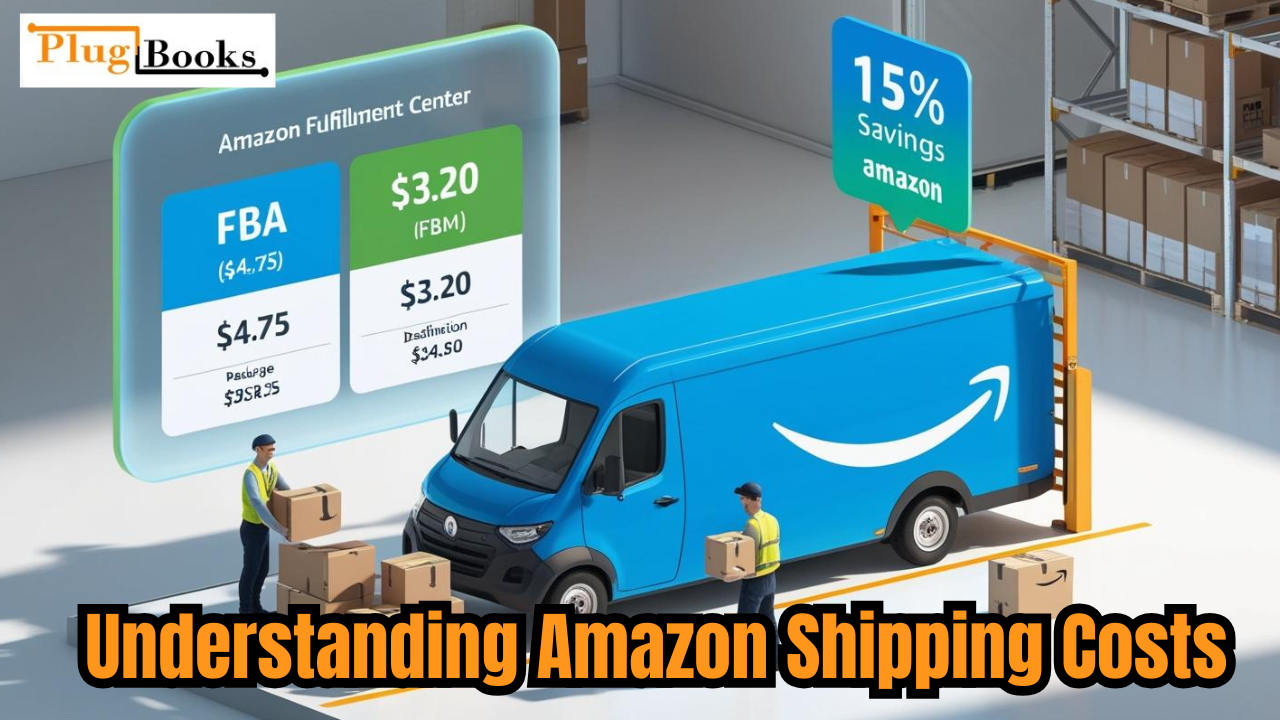For vendors as well as consumers, Amazon shipping costs are a major consideration. Whether you are a consumer or a seller attempting to understand these fees, it is crucial to grasp how Amazon’s shipping costs are set. This blog post will go over Amazon’s shipping charges, how they are calculated, and how best to manage these expenses. By the end, you’ll know exactly how much Amazon shipping cost and how best to arrange your shipping.
Keynotes
- Amazon shipping costs depend on product size, weight, and destination.
- FBA has fixed fees, while FBM offers more control over shipping carriers.
- Reduce shipping costs by optimizing packaging, using FBA, or offering free shipping.
- Use Amazon’s shipping cost calculators to estimate fees and plan shipping.
- Plugbooks.io integrates with Amazon and QuickBooks to track and manage shipping costs.
What Are Amazon Shipping Costs?
The type, size, shipment method, and location of the item affects the cost of Amazon shipping among other things. Fulfilled by Amazon (FBA) and Fulfilled by Merchant (FBM) are two main ways Amazon allows sellers to get their goods delivered. For every method sellers must consider, shipping costs on Amazon.
1. FBA (Fulfilled by Amazon)
With Amazon’s FBA, or fulfillment by Amazon, it can keep, choose, pack, and send your goods. FBA does cost money even if it makes sending faster and simpler easier. For instance, there are storage fees and fulfillment charges. The weight and size of the item mostly determine the fees; items that are larger or heavier cost more.
2. FBM (Fulfilled by Merchant)
If you opt for FBM, you handle the storage, packaging, and shipping directly. In this case, shipping cost on Amazon depends on the shipping carrier you choose (e.g., USPS, UPS, FedEx) and the size/weight of your products. FBM sellers are also responsible for handling returns and customer service, which can add additional costs.
When deciding the pricing for their goods, vendors have to consider the cost of Amazon shipping both ways. You must understand how these expenses are distributed if you are to maintain good margins.

How to Calculate Amazon Shipping Costs
Calculating the cost of Amazon shipping is not as complicated as it may seem, but there are several components you need to consider:
- Shipping Method: Among the other shipping options available are one-day, quick, and normal shipping. The cost increases with increasing shipment time. Additionally you have to choose between FBA and FBM, which alters the computation.
- Size and Weight: Shipping heavier and larger items costs extra. Amazon uses weight and size to determine the FBA purchase value for delivery costs. The weight of the cargo and the shipping firm affect FBM sellers’ shipping prices.
- Shipping Destination:The cost of delivery of the goods influences also the shipping cost. sending inside the same nation usually costs cheaper than sending to another nation most of the time. Shipping will become really expensive if you wish to sell your items anywhere in the globe.
- Fulfillment Method: For FBA sellers, Amazon sets delivery fees; for FBM merchants, they can evaluate rates from several shipping providers to choose the best offer.
Using the size, weight, and shipping method of the item, Amazon’s comprehensive shipping price calculator allows you to project how much the cost of Amazon shipping. FBA buyers who wish to maximize their delivery plan and maintain minimal fulfillment expenses will especially find this tool useful.
How to Reduce Shipping Costs on Amazon
There are several strategies sellers can use to reduce shipping cost Amazon, making their business more cost-effective:
1. Use Amazon FBA for Bulk Shipping
FBA may save a lot of money on shipping if you are selling a lot of products. For FBA customers, Amazon provides reduced rates, which might help to cut the delivery costs for every item.
2. Optimize Packaging
Cut the volume of your packing to lighten it. This will reduce the cargo’s weight, so lowering the shipping expenses. Shipping goods in boxes too large and lacking in coverage could be more expensive.
3. Offer Free Shipping
People who buy on Amazon anticipate free shipping, and it’s among the finest strategies to boost sales. Although you might have to include shipping expenses into the price of your goods, it will increase sales and help you climb the Amazon ranks.
4. Consider Shipping Promotions
Amazon frequently offers savings on shipping along with sales. Look for these opportunities to cut the delivery costs. Certain special plans can additionally provide free shipping on some items or during specific periods.
5. Use Amazon’s Shipping Calculator
Use Amazon’s Shipping Calculator: Amazon provides consumers with means to estimate the cost of delivery. This provides you extra data to assist in your decision on whether to ship via FBA, FBM, or another method.

Why Shipping Cost on Amazon Matters for Sellers
You must understand Amazon’s shipping cost if you are trying to control business expenses. Particularly for members of Amazon Prime, there is a lot of competition; therefore, your shipping expenses will significantly affect your profitability. If the delivery fees are excessively costly, people might not purchase from you especially if you have rivals providing free or discounted shipping.
The expenses can mount rapidly for FBA purchasers, and poor tracking of their shipping expenses could cause losses on transactions. Although FBM vendors might have more influence on their shipping expenses, their only responsibility is to monitor such expenses and ensure that orders are timely filled.
Setting your prices with consideration for shipping cost Amazon will help you maintain your company profitable and ahead of the competitors.
Shipping Cost Amazon: FBA vs. FBM
There are significant differences in the cost of Amazon shipping between FBA and FBM. With FBA, sellers benefit from Amazon’s established infrastructure and discounted shipping rates. FBA does, however, levy storage costs and delivery fees that vary depending on the weight and size of the item.
Conversely, FBM allows consumers greater control over their delivery expenses. Letting sellers talk about pricing with shipping providers has only one negative aspect: they have to manage the entire logistics process including storage, packing, and delivery. This can take more time and cost more money for customers with a lot of stuff.
The key takeaway here is that the cost of Amazon shipping for FBA and FBM can be significantly different, and sellers must carefully weigh both options based on their needs, business size, and customer expectations.
How Plugbooks Helps Manage Amazon Shipping Costs
For Amazon consumers who wish to keep better track of their shipping expenses and operate their company more smoothly, Plugbooks.io is a terrific solution. By tracking expenses like cost of Amazon shipping, Plugbooks.io helps one easily understand and manage the expenditures associated with selling on Amazon. Connecting Plugbooks.io to your Amazon selling account allows you to view exactly how much your shipping expenses are and make wiser decisions to maximize income.
Using Plugbooks.io with financial tools like QuickBooks also helps keep your company’s finances in line, therefore freeing more time to concentrate on increasing sales and sending things more rapidly. Working with Amazon helps QuickBooks maintain real-time tracking of all your expenses, including cost of Amazon shipping. Making this connection helps you to maintain your books accurate and properly handle shipping charges.
Conclusion
All things considered, consumers of Amazon who wish to maximize their profits and provide competitive prices must be aware of the cost of Amazon shipping. Understanding how these expenses are computed and applying tools like FBA or shipping calculators will help you to save money and enhance your delivery strategy. Tracking weight, packaging, and location whether you utilize Amazon’s FBA service or send your goods yourself will help you control expenses.
Knowing what to do will help you to readily control shipping expenses. For your clients as well as for you, this will ensure a seamless transaction. Maintaining organization and tracking your shipment costs can be done with products like Plugbooks.io. This will enable you to make fact-based decisions.
Disclaimer
This blog is meant to be informative solely. Many factors, like the type of goods being transported, where it is going, and how it is being fulfilled, can affect Amazon shipping prices. To be sure you know everything about the shipping charges for your company, always refer to Amazon’s official seller guidelines or consult a specialist.

FAQs
1. What is the average Amazon shipping costs?
The weight and size of the item, where it is being shipped, and how it is being fulfilled determine the shipping expenses. Generally speaking, FBA is less expensive per item than FBM for sellers of a lot of goods. FBM providers determine their own shipping rates.
2. How can I have Amazon transport my goods at less cost?
Using FBA will help you to reduce your shipping expenses by ensuring that your packages are the correct size, offer free shipping, or benefit from Amazon’s shipping specials.
3. Does Amazon charge for delivery of every item it carries?
Amazon does charge for delivery, however the cost varies based on the item’s weight, size, location, and chosen fulfillment type (FBA or FBM).
4. How can I track my shipping costs on Amazon?
Use Amazon’s built-in shipment planner or another application like Plugbooks.io to record your shipping expenses in line with your other company expenses.
5. Does shipping from Amazon cost more when you send something internationally?
Indeed, the additional fees and longer distances of foreign shipping add to its cost. Consider this while determining your pricing if you are selling worldwide.



